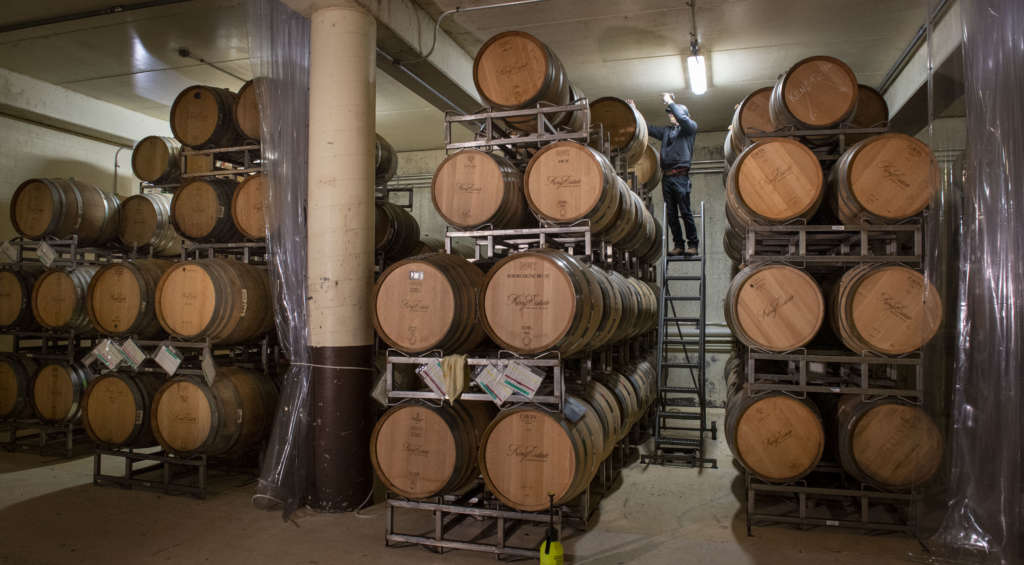Stroll through our cellar right after harvest and along with the heady perfume of fermenting wines your nose might detect something akin to freshly baked bread. Your nose isn’t deceiving you. During fermentation, yeast is added to most wines to convert wine’s natural sugars to alcohol. “Without yeast, all we would have is very sweet juice that is pretty high in acidity,” says Assistant Winemaker Matt Danner, who oversees the yeast program for King Estate.
Breaking Down What Yeast Does
Yeast is essential to the fermentation process. There are two types of yeast: commercial and native (also called wild or indigenous). Commercial yeast is added by winemakers. Native yeast occurs naturally because strains of yeast are present in the vineyard or winery.
When yeast converts sugar into alcohol, it creates carbon dioxide and heat. “This is how the dough in bread rises, how malted grain turns into beer and (how) grape must turns into wine,” writes Anne Krehbiel, MW, in Wine Enthusiast. As the wines ferment, the temperature in the cellar actually warms up, signaling that the yeast is doing its thing.
Adding yeast is acceptable in making wine with Biodynamic® grapes because it is part of the natural process. King Estate uses organic commercial yeast because it gives the winemakers more control over the finished product. Wild yeasts are by their nature unpredictable, are more likely to fail (what is known as a stuck fermentation) and may result in a less desirable finished product. Juice without fermentation is vinegar – useful but hardly wine.
Matching Yeasts With Wine
Yeasts are not one size fits all. Over the summer, Matt turns his attention to looking at the types of yeast that he’s going to order in preparation for the upcoming harvest. “We use different types of yeast for different programs and different styles of wine,” Matt says. “Even within our own Pinot Noir program we’re going to be using six to eight different individual strains of yeast to really highlight the different aspects of each vineyard.”
The choice of yeast affects the speed of fermentation which in turn helps bring out certain characteristics of the fruit, such as the aromatics, texture, complexity and flavor profile.
The process of introducing yeast into wine is accomplished using a yeast rehydrator. The machine looks high tech but what it’s doing is quite simple, much like what the home baker does when baking bread: adding warm water to the yeast to activate it before cooling it down so, when the yeast is added to the juice in the fermentation tank, they are the same temperature. Using technology to carry out these steps means it will be done accurately, efficiently and at the proper time. The whole process takes about 90 minutes.
Striking The Right Balance
In addition to needing warm temperatures and sugar to thrive, yeasts require additional nutrients like vitamins and nitrogen, all in an environment that isn’t too acidic. “As long as these conditions are met, yeasts will ferment fresh grapes into delicious wine,” Wine Enthusiast’s Krehbiel says. Once the yeast is loaded into the rehydrator, the winemakers introduce a mixture of juice and nutrients and turn the machine on. Additional nutrients are gradually added as needed to produce a healthy culture for making wine.

After this process is completed, the wines go into fermentation tanks: for 10 to 14 days for red wines, 30 to 60 days for white. There the white wines will age on the lees in stainless tanks or oak barrels for three to six months. Red wines will be barreled down to age anywhere from 10 to 18 months.
“Yeast is fascinating to me because there are so many complex biochemical reactions going and each one plays a critical part of the process,” Matt concludes. “If we didn’t get it right, the wine could be diminished or even ruined. And yet, if we handle it well, the yeast component can make a good wine really spectacular. It’s the unsung hero of winemaking.”
